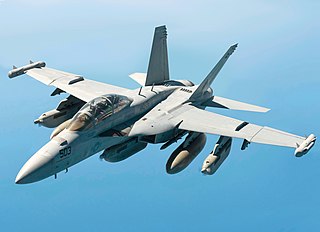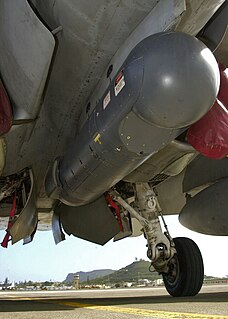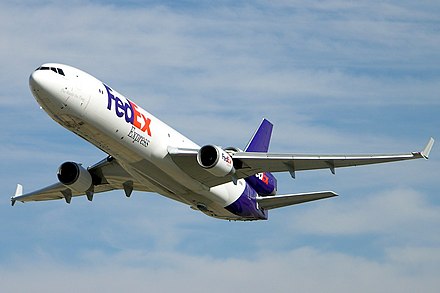
The Northrop Grumman E-8 Joint Surveillance Target Attack Radar System is a United States Air Force airborne ground surveillance, battle management and command and control aircraft. It tracks ground vehicles and some aircraft, collects imagery, and relays tactical pictures to ground and air theater commanders. The aircraft is operated by both active duty U.S. Air Force and Air National Guard units and also carries specially trained U.S. Army personnel as additional flight crew.
McDonnell Douglas was a major American aerospace manufacturing corporation and defense contractor formed by the merger of McDonnell Aircraft and the Douglas Aircraft Company in 1967. Between then and its own merger with Boeing in 1997, it produced a number of well-known commercial and military aircraft such as the DC-10 airliner, the F-15 Eagle air superiority fighter, and F/A-18 Hornet multirole fighter.

The McDonnell Douglas MD-11 is a wide-body airliner manufactured by American McDonnell Douglas (MDD) and later by Boeing. Following DC-10 development studies, the program was launched on December 30, 1986. Assembly of the first prototype began on March 9, 1988, it rolled out in September 1989 and made its maiden flight on January 10, 1990. FAA certification was achieved on November 8, the first delivery was to Finnair on December 7, and it entered service on the 20th.

The McDonnell DouglasF-15E Strike Eagle is an American all-weather multirole strike fighter derived from the McDonnell Douglas F-15 Eagle. The F-15E was designed in the 1980s for long-range, high-speed interdiction without relying on escort or electronic-warfare aircraft. United States Air Force (USAF) F-15E Strike Eagles can be generally distinguished from other U.S. Eagle variants by darker aircraft camouflage, conformal fuel tanks (CFTs) mounted along the engine intake ramps and a tandem-seat cockpit.

The Northrop/McDonnell Douglas YF-23 is an American single-seat, twin-engine stealth fighter aircraft technology demonstrator designed for the United States Air Force (USAF). The design was a finalist in the USAF's Advanced Tactical Fighter (ATF) competition, battling the Lockheed YF-22 for a production contract. Two YF-23 prototypes were built, nicknamed "Black Widow II" and "Gray Ghost".
The Northrop Grumman E-10 MC2A was planned as a multi-role military aircraft to replace the Boeing 707-based E-3 Sentry and E-8 Joint STARS, the Boeing 747-based E-4B, and the RC-135 Rivet Joint aircraft in US service. The E-10 was based on the Boeing 767-400ER commercial airplane.

The Boeing EA-18G Growler is an American carrier-based electronic warfare aircraft, a specialized version of the two-seat F/A-18F Super Hornet. The EA-18G replaced the Northrop Grumman EA-6B Prowlers in service with the United States Navy. The Growler's electronic warfare capability is primarily provided by Northrop Grumman. The EA-18G began production in 2007 and entered operational service with the US Navy in late 2009. Australia has also purchased twelve EA-18Gs, which entered service with the Royal Australian Air Force in 2017.

Directional Infrared Counter Measures (DIRCM) are a class of anti-missile systems produced to protect aircraft from infrared homing MANPADS. It is a light-weight and compact system designed to provide mission-vulnerable aircraft with increased protection from common battlefield threats. It is more advanced than conventional infrared countermeasures. Aerospace companies, such as Leonardo S.p.A., Elbit Systems, Northrop Grumman, ITT Corporation, and BAE Systems, are designing these systems.

The AN/AAQ-28(V) LITENING targeting pod is an advanced precision targeting pod system currently operational with a wide variety of aircraft worldwide. The research and development of the LITENING was first undertaken by Rafael Advanced Defense Systems' Missiles Division in Israel, with subsequent completion of LITENING I for use in the Israeli Air Force.

Man-portable air-defense systems are portable surface-to-air missiles. They are guided weapons and are a threat to low-flying aircraft, especially helicopters.

An infrared search and track (IRST) system is a method for detecting and tracking objects which give off infrared radiation such as jet aircraft and helicopters.

FedEx Express, formerly Federal Express, is a cargo airline based in Memphis, Tennessee, United States. In 2017, it was the world's largest airline in terms of freight tons flown and the world's ninth largest in terms of fleet size. It is the namesake and leading subsidiary of FedEx Corporation, delivering freight and packages to more than 375 destinations across all six continents each day.

An infrared countermeasure (IRCM) is a device designed to protect aircraft from infrared homing missiles by confusing the missiles' infrared guidance system so that they miss their target. Heat-seeking missiles were responsible for about 80% of air losses in Operation Desert Storm. The most common method of infrared countermeasure is deploying flares, as the heat produced by the flares creates hundreds of targets for the missile.
Civil Aircraft Missile Protection System or CAMPS is an infrared countermeasure against infrared-homed anti-aircraft missiles, specifically designed to defend civilian aircraft flying under 15,000 feet (4,600 m) against MANPADS.
Flight Guard is an Elta Systems Ltd's brand name for a family of airborne systems for protecting civilian aircraft against man-portable air-defense systems.
Project CHLOE is a research and development program of the Department of Homeland Security (DHS) to explore technology-based unmanned aerial vehicle (UAV) mounted defenses for airports and airliners against the threat of infrared man-portable anti-aircraft missiles. The project's name refers to the character Chloe O'Brian on the television show 24, which is Former Homeland Security Secretary Michael Chertoff's favorite show.

The Boeing AH-6 is a series of light helicopter gunships based on the MH-6 Little Bird and MD 500 family. Developed by Boeing Rotorcraft Systems, these include the Unmanned Little Bird (ULB) demonstrator, the A/MH-6X Mission Enhanced Little Bird (MELB), and the proposed AH-6I and AH-6S.

A missile approach warningsystem (MAW) is part of the avionics package on some military aircraft. A sensor detects attacking missiles. Its automatic warning cues the pilot to make a defensive maneuver and deploy the available countermeasures to disrupt missile tracking.
The Vigilant Eagle Airport Protection System is a proposed directed-energy weapon under development by the U.S. military under a Defense Department contract with Raytheon. It would create an invisible microwave dome around an airport that could block missiles heading toward incoming and outgoing aircraft.
CIRCM, the Common Infrared Countermeasures program, is a United States Army initiative intended to develop a lightweight, low-cost and modular laser-based infrared protection system for U.S. helicopters and light fixed-wing aircraft. The technology will primarily provide defense against shoulder-fired, heat-seeking missiles, or MANPADS. The program is being developed to replace older suites such as the Advanced Threat Infrared Countermeasures (ATIRCM).

















